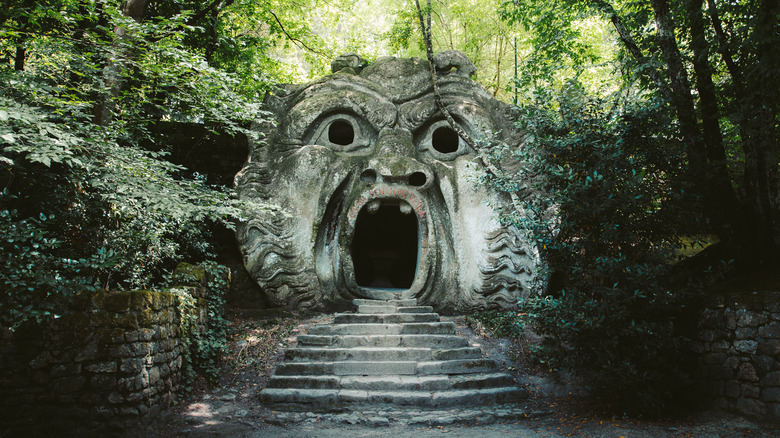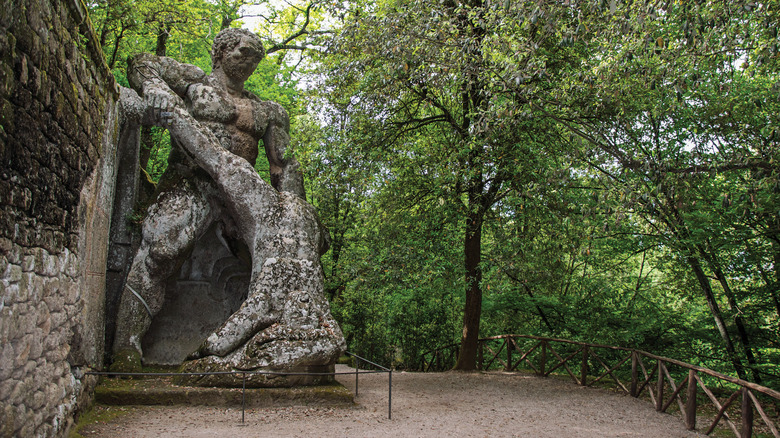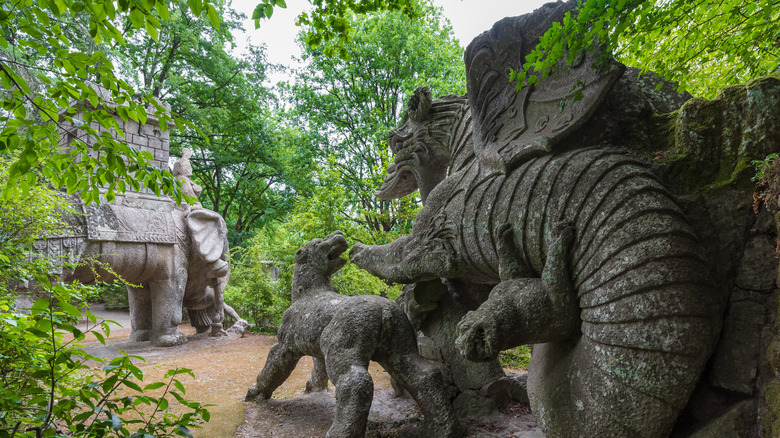The Unusual Garden In Italy That Leaves Fans Of Both Nature And Horror Very Satisfied
In the hilly Italian landscapes of Bomarzo in the northern part of Lazio lies a 500-year-old garden unlike any other. Known as the Park of the Monsters, Garden of Bomarzo, or Sacro Bosco ("Sacred Grove" in Italian), this enigmatic space immortalized the grotesque and mythological, creating an experience that satisfies both nature enthusiasts and fans of the macabre. It is the oldest existing sculpture park in the modern world.
The Garden of Bomarzo was commissioned for over 30 years during the mid-16th century by Prince Pier Francesco Orsini, a military leader and patron of the arts who was grieving the death of his wife. He wished to create a "Villa of Wonders." He enlisted the help of one of the most renowned architects at the time, Pirro Ligorio, who later completed St. Peter's Basilica in Rome after Michelangelo's passing. The garden was designed not to please but to astonish, and it served as a physical manifestation of Orsini's deep sorrow and complex inner world.
Unlike typical Italian Renaissance gardens that championed symmetry and order, the Garden of Bomarzo was a radical departure into a Mannerist style. It embraced chaos and the unexpected, the bizarre and fantastical. As you enter the park, you will see a pair of sphinxes guarding the gates. An inscription reads, "You who enter here, put your mind to it part by part, and tell me then if so many wonders are made as trickery or as art?"
Myths and creatures at the Garden of Bomarzo
Sacro Bosco's most notable feature is its larger-than-life sculptures, some growing directly from the landscape's bedrock, others made from a local volcanic stone called peperino. These sculptures range from ancient myths to disturbing figures, all imbued with symbolic meanings. The gaping mouth of Orcus, an ogre-like creature known as the "Mouth of Hell," contains a table large enough for people to eat (while getting eaten). A leaning house tilted at 23 degrees disorients and challenges visitors' perception of space.
There are also depictions of Greek mythology and various exotic animals that would have been unknown to 16th-century Italians. A fountain of Pegasus, Hercules fighting Cacus, and a half-woman, half-serpent statue of Echidna are just a few of many peculiar stone creations. However, the last addition to the park was a temple built in honor of the Prince's wife. It is no wonder that each moss-covered memento across the 7.5-acre garden happens to be part of a larger story.
The garden's design is believed to have been influenced by Orsini's interests in mythology, ancient literature, and alchemy. This is evident in the astrological nature of the sculptures, the park's labyrinthine layout, and the cryptic and often poetic engravings. "Rather than seeking a unified narrative message, it is more appropriate to take our cue for meaning from the relationship between the carved inscriptions in the garden and the sculptures they accompany, which Orsini surely intended," explains Dickinson College professor of art history and humanities Melinda Schlitt (via BBC).
See the Sacro Bosco monsters for yourself
After Orsini died in 1585, the garden fell into despair. The artificial lake that fed the fountains dried out, and the once brightly painted statues became overgrown and forgotten. In the 20th century, the Park of Monsters was rediscovered. Artists like Salvador Dalí and Jean Cocteau drew inspiration from its surreal elements; Dalí even shot a short film there and based a 1946 painting on the park. Sacro Bosco influenced movies, novels, and operas.
In 1951, a real estate developer, Giovanni Bettini, stumbled upon the neglected park and fell in love. He bought it, and in the 1970s, the Bettini family facilitated a complete restoration. The park is still privately owned by this family and open to the public. Today, the Garden of Bomarzo attracts 40,000 annual visitors from all over the world, appealing to an array of interests — from Renaissance art to botanical gardens and from Gothic horror to esoteric philosophy.
The garden is 57 miles north of Rome, less than a two-hour drive. It's accessible by car or public transport, but the easiest way to visit is by car. If you're using public transport, take a train to Orte or Viterbo from Rome and then a bus or taxi to Bomarzo. Tickets can be bought for €14 each on the Sacro Bosco website. Plan to spend around two hours exploring. In the Park of Monsters, "May each one find there what is closest to his heart and may all get lost" (via Speculum Artis).


